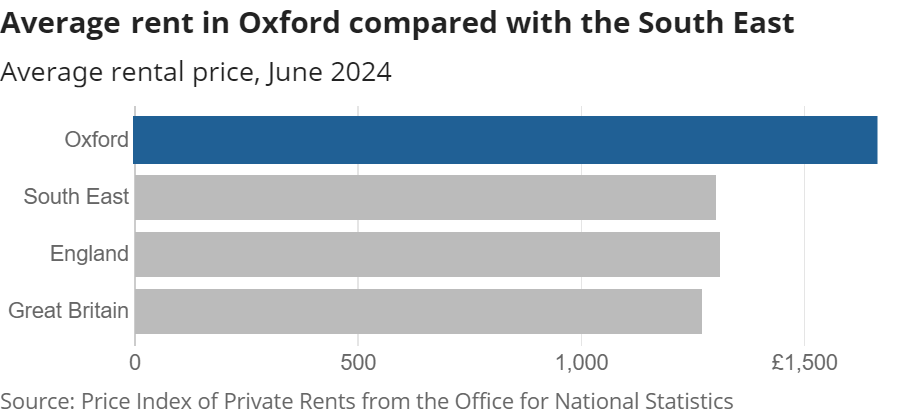Over the past decade, Oxford‘s housing market has undergone significant transformations considering the city’s growing demographics, economic factors, and urban development. Oxford is known for its prestigious universities and rich history. However, in recent times, Oxford has faced unique challenges in balancing its growing population’s housing needs with the preservation of its distinctive character.
Let us explore the key changes that have shaped Oxford’s housing landscape from 2011 to 2021, offering insights into the factors driving these shifts and their implications for the future.
Demographic Shifts
According to the data provided by the Office for National Statistics, Between the 2011 and 2021 censuses, Oxford’s population grew by 6.7%, reaching approximately 162,000 residents. While this growth rate was slightly lower than the South East region’s 7.5% increase, it aligned closely with the national average for England of 6.6%. This population surge has had a profound impact on the city’s housing demand and urban density.
Oxford’s population density increased from 23.8 to 25.4 people per football pitch-sized area from 2011 to 2021. This places it among the top 20% most densely populated English local authority areas. This rise in density has put pressure on existing housing stock and infrastructure, necessitating innovative urban planning solutions.
The city’s age demographics have also shifted noticeably. The median age in Oxford increased from 29 to 31 years, remaining significantly lower than the national median of 40 years. This youthful population profile is largely attributed to the city’s thriving student community and its appeal to young professionals.

Image Source: ons.gov.uk
Interestingly, Oxford saw a 22.8% increase in residents aged 50 to 64 years, while the number of children aged 4 and under decreased by 22.9%. This trend suggests a growing need for housing options that cater to an ageing population, as well as potential changes in family structures within the city.

Oxford Residents Age Demographics
Image Source: ons.gov.uk
Oxford Housing Market Dynamics

The changes in Oxford’s demographics have significantly impacted the local housing market. According to the census from 2011 and 2021, the percentage of households including a couple without children rose from 14.8% to 15.6%, while households with dependent children increased from 16.6% to 18.0%. These shifts reflect changing family structures and living arrangements, influencing the types of housing in demand.

Image Source: ons.gov.uk
According to the Office for National Statistics, the average house price in Oxford surged from £386,000 in 2023 to £400,000 in 2024, representing a staggering 39% increase. This growth outpaced both the regional and national averages, highlighting the intense pressure on Oxford’s housing market.


Image Source: ons.gov.uk
For comparison, the average house price in the South East region rose from £250,000 to £365,000 over the same period, while the national average for England increased from £170,000 to £275,000. These figures underscore the significant premium placed on housing in Oxford, highlighting its desirability and demand as a place to live and work.
Oxford Rental Market
The rental market in Oxford has experienced substantial growth in recent years. As of June 2024, the average monthly private rent in Oxford stood at £1,663, reflecting a 4.3% increase over the previous year. This rapid rise in rental prices has made it increasingly challenging for residents to find affordable housing options, further intensifying the reliance on the rental market.

Image Source: ons.gov.uk
Looking ahead, the Oxford rental market is expected to continue its upward trajectory. Analysts predict that rental prices will keep increasing due to ongoing demand and limited housing supply.
Download Complete Demographic Data for Oxford Housing Market
Factors Influencing Oxford Housing Affordability
Several factors have contributed to the evolving affordability of housing in Oxford. The city’s strong economic performance, driven by its world-renowned universities and innovation sectors, has attracted a steady influx of students, academics, and professionals. This sustained demand has put upward pressure on both house prices and rental rates.
The limited supply of new housing, constrained by Oxford’s historic layout and green belt restrictions, has struggled to keep pace with demand. This supply-demand imbalance has been a key driver of price increases, making homeownership increasingly challenging for many residents.
New Developments and Urban Planning
In response to the growing housing demand, Oxford has seen the development of several new residential projects in recent years. These developments aim to provide a mix of housing types to cater to the diverse needs of the city’s residents.
One notable example is the Barton Park development, which will provide up to 885 new homes, including affordable housing and community facilities. This project exemplifies the city’s efforts to create sustainable, well-connected communities with a focus on green spaces and active travel options.
Urban planning in Oxford has focused on striking a delicate balance between meeting housing needs and preserving the city’s historic character and green spaces. The Oxford Local Plan 2036, adopted in 2020, sets out a vision for sustainable growth and development. It identifies areas for new housing and employment growth while protecting the city’s natural environment and heritage assets.
The plan emphasises the importance of creating well-designed, liveable communities that meet the needs of Oxford’s diverse population. This includes provisions for affordable housing, sustainable transport links, and community facilities.
Lifestyle Changes and Housing Preferences
As Oxford’s population has grown and diversified, housing preferences and lifestyle choices have evolved. There has been an increased demand for urban living, with residents seeking properties close to amenities, public transportation, and cultural attractions.
The rise of eco-consciousness has also impacted housing preferences, with growing demand for energy-efficient homes and sustainable building practices. This trend is likely to shape future developments and renovations in the city.
Challenges and Opportunities
While Oxford’s housing market has seen significant growth and development over the past decade, it faces several challenges moving forward. Affordability remains a pressing issue, with many residents struggling to find suitable housing within their budget. This has implications for social mobility and the city’s ability to retain talent across various sectors.
The need to balance new development with the preservation of Oxford’s unique character and green spaces presents an ongoing challenge for urban planners and policymakers. Innovative solutions, such as the redevelopment of brownfield sites and the creation of mixed-use communities, will be crucial in addressing housing needs while maintaining the city’s livability.
Another challenge lies in addressing the diverse housing needs of Oxford’s population. From student accommodation to family homes and retirement living options, the city must ensure a varied housing stock that caters to different life stages and preferences.
Future Trends for Oxford’s Housing Market
As Oxford looks to the future, several factors will shape its housing market. Economic trends, including changes in employment rates, income levels, and interest rates, will play a significant role in determining Oxford housing affordability and accessibility.
Policy decisions, such as the implementation of affordable housing initiatives and the regulation of rental prices, will be crucial in ensuring that Oxford remains an inclusive and diverse city. Community engagement will be vital in shaping these policies and ensuring they meet the needs of all residents.
The ongoing impact of technology on work patterns may influence housing preferences, potentially leading to increased demand for properties in satellite towns and villages around Oxford. This could help alleviate some pressure on the city centre housing market while presenting challenges for transport infrastructure and community services.
How Can SO Storage Help?
As we look to the future, the scope of Oxford’s housing market serves as a microcosm of the challenges and opportunities facing many growing cities worldwide. By learning from its experiences and continuing to adapt and innovate, Oxford can set an example for sustainable urban development in the 21st century.
As Oxford’s housing market continues to evolve, SO Storage is here to support residents, students, and businesses through the city’s transitions. With convenient locations, flexible storage options, and a focus on sustainability, SO Storage offers a reliable solution for all your storage and removal needs.
Whether you’re a student looking for a place to store your belongings during the summer, a family in need of extra space during a move, or a business requiring secure storage for your supplies, including storage insurance, SO Storage has you covered. Fill out the form to get a quote or contact us to learn more about our services and find the perfect storage solution for your needs. Let SO Storage be a part of your journey as Oxford’s housing market adapts to the changing times.
